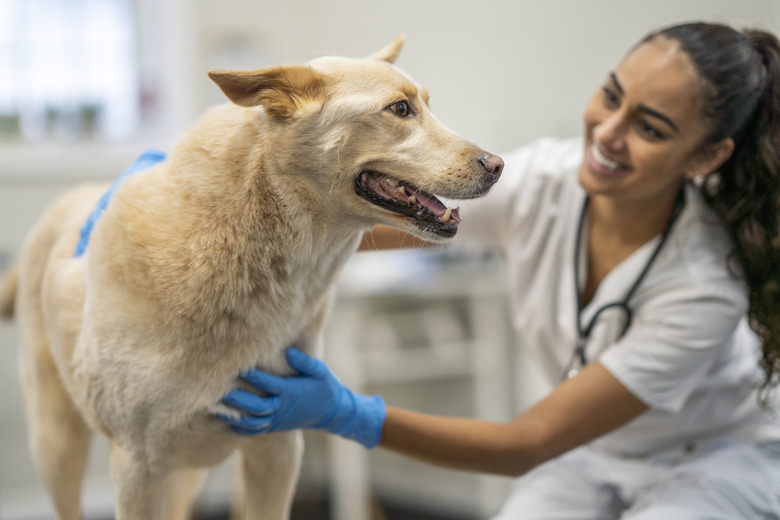Cushing's Disease In Dogs: Symptoms And Diagnosis
Cushing's disease, also known as hyperadrenocorticism and Cushing's syndrome, is an endocrine disorder caused when a dog's adrenal glands produce excess cortisol or cortisone. This hormone plays a broad role in canine health, including helping to regulate body weight and fat reserves, skin health, blood sugar levels, muscle structure, and autoimmunity. Because cortisol affects the functioning of numerous organs, elevated levels can cause a host of debilitating symptoms. Understanding the signs of canine Cushing's disease allows you to get your pet diagnosed and treated more quickly to manage the disease so your dog can live a normal life span.
What is Cushing's disease in dogs?
What is Cushing's disease in dogs?
Cushing's disease in dogs is an endocrine disorder that occurs when the body produces too much cortisol. This causes both physical and behavioral changes and primarily affecting middle-age and older dogs.
The pituitary gland produces the adrenocorticotropic hormone, which causes the adrenal gland to produce cortisol. When something goes wrong in either gland, your dog has excess cortisol productions in the bloodstream and will develop Cushing's disease. There are three different types/causes of Cushing's disease; all share the same symptoms but require different treatments.
Cushing's disease typically occurs in middle-age and senior dogs. The average age of dogs at the time of diagnosis is 10 to 11 years old. Breeds that seem more susceptible to Cushing's disease include:
- Dachshunds
- Beagles
- Terriers, especially Jack Russells
- Boxers
- Poodles
- Cocker spaniels
Causes of Cushing's disease in dogs
Causes of Cushing's disease in dogs
When a dog has Cushing's disease, it is one of three types, each with a different cause. The three types/causes of Cushing's disease are:
- Pituitary tumor: Benign or malignant tumor on the pituitary gland, located at the base of the brain; causes pituitary dependent hyperadrenocorticism, affecting 85 to 90 percent of cases; typical in smaller dogs
- Adrenal tumor: Benign or malignant tumor on the adrenal gland, located in front of the kidneys; causes adrenal dependent hyperadrenocorticism; mostly affects larger dogs
- High levels of steroids given in treatment cause iatrogenic Cushing's disease. Iatrogenic means the Cushing's was caused by a medical treatment.
It is important to determine which type has caused Cushing's disease in a dog because each type is treated differently than the others.
Symptoms of Cushing's disease in dogs
Symptoms of Cushing's disease in dogs
Your dog's symptoms may not be noticeable at first because the disease progresses gradually and because the typical dog's symptoms also occur in other diseases. When symptoms are not normal for your dog, such as a high-energy dog becoming lethargic, consider that they might actually be clinical signs of Cushing's disease.
Early stages of Cushing's disease
The most common early signs of Cushing's disease include:
- Increased appetite due to high cortisol levels. Dogs seem to be constantly ravenous, even stealing food from the garbage and constantly begging for treats.
- Increased water consumption from high levels of cortisol. Dogs are constantly thirsty even though they aren't exercising more often and have not had other lifestyle changes.
- Increased urination from excessive water intake. Dogs might start having accidents in the house or whine to go outside at night because holding the bladder all night has become difficult due to the increased water intake.
Later stages of Cushing's disease
As the disease progresses, you may notice additional symptoms:
- Pot-bellied appearance in about 90 percent of dogs. The bloated, firm belly occurs because body fat shifts into the abdominal area, stretching the abdominal wall. At the same time, the wall muscles become weaker and shrink, leading to a distended appearance.
- Abnormal skin, including flaky, dry, or thin skin that is more prone to bruising and skin infections because the fragile skin does not heal well.
- Changes to the coat often go hand in hand with skin problems. Some dogs experience symmetrical hair loss on their torso but not on their legs or head. The coat might look dull or dry, or it might look oily.
Behavioral changes
Along with physical symptoms, many dogs with Cushing's disease suffer from behavioral changes as well, including:
- Low energy, including lethargy or listlessness
- Lack of interest in usual activities or not responding to you in a normal manner
- Reduced activity level from weakened muscles, including reluctance to exercise, jump on furniture, get into your car, or climb stairs
- Disorientation or excessive pacing
The changes can be subtle at first. Many owners mistake the behavior for depression or old age. It is true that the average age for diagnosis of Cushing's disease is 11, which is the age dogs are considered to be seniors, but that does not mean the disease is a normal part of aging.
Diagnosing Cushing's disease in dogs
Diagnosing Cushing's disease in dogs
Adrenal and pituitary gland tumors typically grow very slowly and therefore may not be life-threatening to your dog. Because of the slow growth, Cushing's disease symptoms often occur gradually over time, leading to the mistaken impression that the signs are that of the normal aging process. In addition, other less problematic health issues have similar symptoms, so many owners don't realize their dogs need medical care until the disease is quite advanced.
Consult your veterinarian if your dog exhibits any symptoms of Cushing's disease. Diagnostic tests could include blood tests, urinalysis, and ultrasound, which are typically used to diagnose the disease and to differentiate which type of Cushing's disease the dog has. Bloodwork and urinalysis detect high blood and urine cortisol levels. Abdominal ultrasounds may confirm the presence of a tumor on one of the adrenal glands, while magnetic resonance imaging (MRI) may show a tumor on the pituitary gland.
If left untreated, the disease becomes progressively worse. Your dog will become more susceptible to heart, kidney, and liver disease as well as diabetes, high blood pressure, blood clots, and seizures. However, Cushing's disease is manageable though not yet curable. With early detection, even senior dogs can live a healthy and happy life for many years after a Cushing's diagnosis.
The bottom line
The bottom line
Cushing's disease affects a dog's whole body, from the skin and coat to individual organs and systems. Left untreated, it can cause serious diseases and conditions, including high blood pressure and diabetes. The symptoms occur gradually and may be mild in the disease's early stages; therefore, they are often overlooked or dismissed as natural changes with aging. Many of the symptoms are also common to other conditions. If your dog exhibits such physical and behavioral changes, it is important to get a diagnosis from your veterinarian, not only that of Cushing's disease but also which of the three types of the disease so that proper treatment can be given.


